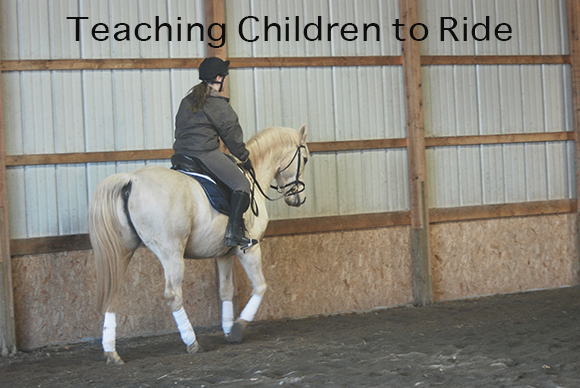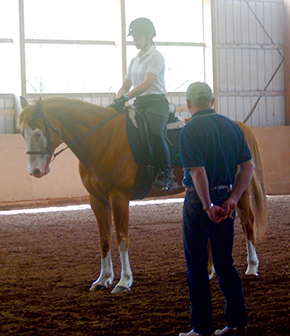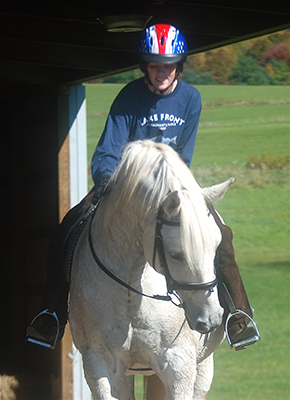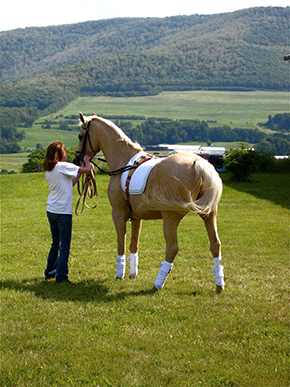Teaching Children to Ride

Teaching children to ride is extremely rewarding. Their enthusiasm, open hearts and keen attitude to learn make children good students. Their fondness of ponies is a joy to behold. Most children are quite fearless when it comes to riding and it is the responsibility of the instructor to ensure their safety comes first and their exuberance to ride is carefully channeled. For the nervous rider much patience is needed but allowing a child to sit on a pony and be led, can work wonders for their self-confidence.
As the instructor it is important to ascertain from the parent the nature of the child in general, their attitude to animals and to horses in particular, their prior experiences riding including any negative or positive events. It is also wise to ask the parent (out of the child’s company), if there are any physical or mental challenges for the child and have some idea of their physique including height. The child’s age and mental maturity and experience training in other sports are also helpful to know. For example, do they do ballet? Gymnastics? This would indicate they have some semblance of balance and are also used to following instructions and being taught. Can they ride a bicycle? Obviously this also requires balance and would demonstrate the child has already mastered some of the skill sets needed for riding.
While a child of any age can sit on a pony and be led about it is generally not beneficial to attempt to train them to ride until they are five or six years old. The advantage of waiting until this age is that the child has time for their limbs to develop and they can understand instructions and have some mental focus.
 It is extremely important to match the child to the pony. All beginners should ride a kind lesson pony that does not exhibit vices, who is safe and nicely forward and not stubborn or pushy. Yes. That can be hard to find!
It is extremely important to match the child to the pony. All beginners should ride a kind lesson pony that does not exhibit vices, who is safe and nicely forward and not stubborn or pushy. Yes. That can be hard to find!
The rider should be taught individually to start out and be led at the walk and then the trot. This will require the aid of a helper who should be experienced with horses. It is almost impossible to properly teach someone to ride when you are leading the pony. It is extremely important that the beginner not be over-faced, especially if they are of timid demeanor. Obviously all mounted work should be done in proper attire, boots with small heels and safety helmets worn at all times and the saddle should be fitted with appropriately sized safety stirrups.
While parents may like the idea of dropping Johnny off for an hour lesson and leaving you ‘ holding the baby,’ it is important that for the first few lessons the parent remain present. An hour lesson is also too much to ask for young students as they will simply overtire and lose focus. They may also become sore from too long a time in the saddle. It is much better for students to ride for half and hour at a time on a regular weekly basis than to do an hour lesson every fortnight. Their progress will be greatly enhanced and this should be made clear to the parent.
Talking of parents it is also important that they understand their responsibilities in this endeavor. As an instructor you would like them to be on time right? That is basic respect for your time, which literally as an instructor is money. Parents should also pay for the lessons on time and not need to be asked for payment. Naturally signed liability waivers should always be collected and the parent should understand the dangers of the sport. The child should be presented ‘ready to go’ and have the appropriate riding apparel and not be overtired or stressed. They should be fed and watered! While it is great for parents to encourage their children by attending the lessons it is not helpful if they interrupt the lessons.
A safe environment is paramount for all riding but especially for children. The arena should be safely gated and enclosed and away from the distractions of other horses that may be turned out nearby and cause upset in a lesson by galloping around. It is also sensible to secure an area where parents and other children can watch in safety and be ‘corralled’.
The instructor should explain to the child student how they would like to be addressed and keep the lines of communication open when they teach. Lessons should always leave the young student eager to learn more. Language used to instruct is very important. Instructions should be kept in simple terms and be succinct.
As with any learning relaxation is the key to success. Humor is appreciated by riders of all ages and is a great way to relax the rider.
Lessons should always include all safety aspects. For example, explaining to a child this is the girth and this must always be tight before you mount. The first lesson may cover basic grooming and tacking up instruction, how to safely mount and dismount, how to walk and halt. If the child is working well and shows good balance a trot may be included. Trot periods should be in straight lines and of short duration.
We all know that learning to sit the trot can be difficult. For the English discipline it is wise to teach the child how to post from the start. Who wants to be bumped up and down, jolted about and generally made uncomfortable. For the Western rider the horn of the saddle is a blessing from heaven when teaching the child to ride as they can grasp the horn at any time to rebalance. On an English saddle an ‘emergency’ strap can be fitted to the front of the saddle. Personally I prefer to teach the beginner with this strap as it will keep their hands steady and off the horse’s mouth.
 If you see the child sticking out their tongue, don’t take it personally. It is just a byproduct of their concentration. It is a safety issue though so they should be taught to keep their tongue inside the mouth to prevent them biting down on it should the pony misstep or falter.
If you see the child sticking out their tongue, don’t take it personally. It is just a byproduct of their concentration. It is a safety issue though so they should be taught to keep their tongue inside the mouth to prevent them biting down on it should the pony misstep or falter.
Interestingly should a pony trip or other event happen that causes the child to become unseated most children will simply plop to the floor. They will make no effort to regain their position in the saddle and may teeter on the brink of disaster. As an instructor you have to keep a watchful eye and if they come out of the saddle and the pony is user friendly and kindly stops, then be sure to explain to them how to regain their position.
When the child is ready to come off the lead line it is wise to explain to them that now they are free of the line they are responsible for the wellbeing of their mount. From the beginning the child should understand they are 51% of the partnership and that they must issue direction to their pony or the pony will quite literally take matters into his own hooves.
Initially, there will be steering problems that arise off the line, as the child and pony will take to the road like a texting driver. Sometimes weaving into the lines of oncoming traffic. So it may be helpful to have another rider mounted on a sensible beast (a rider hopefully with more advanced abilities) join the lesson, for the newbie to follow and to have the arena free of any other riders who may cause more distraction than help.
First rides outside of the ring can be undertaken once the child is able to stop and go, handle all three gaits without fear or hauling on the pony’s mouth. It is a great idea to pony the child from another horse in the early stages. This way if their mount spooks or rushes or causes alarm, the instructor can offer immediate advice on how to handle the issues of the trail and nip any nervousness or bad outcome in the bud.
Of course if the pony is 12hh and the instructor’s only available mount is 16.2hh then this may not be feasible. In that event if it is possible the first rides out on the trail should have two good riders on a sensible horses ride in front and behind the child student.
 On my arrival from England to New York I wasted no time in visiting a local riding facility and was amazed that whether I had riding experience or not, the management would allow me to go out on a trail ride. In England this would not be allowed unless I had proven myself proficient in the saddle. Once the barn owner realized I was an advanced rider she allowed me to ride out alone. I would often meet the ‘group’ rides on the trail in the State park and was stunned at the danger that was apparent as they cantered past me en masse, the students faces in varying degrees of terror and excitement. Some were clearly in danger of toppling off the side. One day as I was riding out the entire herd of horses, all missing their human counterpart, came galloping toward me. I took my horse up on the bank and watched in horror as the horses bolted off in a cloud of dust to the barn. I cantered my horse up the trail to find the missing persons and found people strewn about in various states of ‘upset’ between the trees and bracken and on the sandy trail. Some wandering about like a bunch of drunken college kids, some brushing sand from their heads. All completely bewildered and unable to answer my questions as to whether they were hurt and what had happened.
On my arrival from England to New York I wasted no time in visiting a local riding facility and was amazed that whether I had riding experience or not, the management would allow me to go out on a trail ride. In England this would not be allowed unless I had proven myself proficient in the saddle. Once the barn owner realized I was an advanced rider she allowed me to ride out alone. I would often meet the ‘group’ rides on the trail in the State park and was stunned at the danger that was apparent as they cantered past me en masse, the students faces in varying degrees of terror and excitement. Some were clearly in danger of toppling off the side. One day as I was riding out the entire herd of horses, all missing their human counterpart, came galloping toward me. I took my horse up on the bank and watched in horror as the horses bolted off in a cloud of dust to the barn. I cantered my horse up the trail to find the missing persons and found people strewn about in various states of ‘upset’ between the trees and bracken and on the sandy trail. Some wandering about like a bunch of drunken college kids, some brushing sand from their heads. All completely bewildered and unable to answer my questions as to whether they were hurt and what had happened.
Indeed, whenever I mention horses to someone they often say,
“Oh yes I rode a horse once. I didn’t like it.“ You can imagine the reasons on which they then expound.
It rolled and I fell off. It bolted I fell off. It bit me before I got on. It bit me when I got off. It was bitten by another horse so it turned around, they had a fight and I fell off. It trod on my foot. It wouldn’t go. It wouldn’t stop. It had no steering. You get the idea.
So sad that their riding experiences were cut short by such negative adventures many of which might have been prevented if they had taken instruction from a good instructor out the outset.
Happy Riding!


